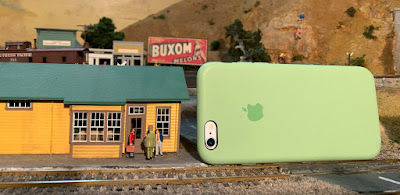Now that a very large majority of people carry cell phones, and take a lot of their snapshots with those phones, it may be that more options are opened up than one immediately realizes. What I address in the present post is layout photography. My modeling is HO scale, and getting down to “eye level” (of an HO person), or getting into a layout area with lots of “impediments” (structures, say), can be a problem with a conventional SLR.
Now don’t get me wrong. I use my digital SLR all the time for model photography, and it has a lot of capabilities far beyond the simple cameras of cell phones. But it won’t fit in tight places, and the roughly two-inch diameter of the lenses I use make the center of that distance the “bottom” viewpoint for photography. However, below is something familiar to practically everyone: the back of a cell phone in a rubber case (it happens to be an iPhone).
Here’s my point: the cell phone lens in this phone is less than 3/4-inch from the phone edge. Placed on the layout, this permits a viewpoint as low as, or even below, that of an HO scale person. To demonstrate, here is another cell phone at the Shumala depot on my layout. The lens center, as you can see, is a little above waist height of the HO figures. So actually you need to raise the cell phone, with lens downward like this, to achieve an “HO eye-level” view.
I have experimented with this kind of photography, and sometimes a quite nice photo is possible. One major disadvantage is depth of field, though with careful composition this can be used to advantage, as it can make less noticeable the areas you don’t want to show. Here is an example, from the engine terminal at Shumala:
The distant water tank doesn’t intrude too much into the main subject.
Another example is this shot of workmen preparing to ice a reefer at the Shumala ice deck. Nearly everything of interest is in focus. The cluster of stores in the right distance don’t distract.
But some shots really would require a through-focus series of images, assembled with photo-stacking software such as Helicon Focus. The image below, of the Santa Rosalia Local departing Ballard westward on my layout, does offer the drama of the head-on perspective, but a great deal of the image is out of focus.
As I mentioned, the cell phone’s size and slender shape allows it to be inserted into the layout at places not otherwise accessible by conventional SLR on a tripod. The example below is the unloading platform for high-pressure tank cars at the Pacific Chemical Repackaging facility in my layout town of Ballard. This viewing angle would not be accessible any other way.
For a final example, I have been experimenting with views that one might take if one were at the prototype equivalent scene, particularly ones with angles or perspectives not usual in model photography on layouts. The view below, of one of my SP Consolidations (a Key model), is an example. The fireman here, with a cigarette in his mouth, is a trademark of Al Massi, who tuned up the mechanism and installed DCC and sound.
These example show that there are a lot of possibilities for model photography with cell phones, beyond simply snapshots or overall grab portraits on layouts. It’s worth experimenting to find out what you can achieve.
Tony Thompson







I have two recommendations with regard to depth-of-field. First is to use "CameraPixels" on the iPhone for "Focus Bracketing". Googling those two phrases should result in instructions. Second is to do focus stacking using FREE software like CombineZP. For some reason, many people recommend HeliconFocus, which is probably great, but is very expensive. CombineZP was good enough for Tom Ebert & my article in Great Model Railroads.
ReplyDeleteRegards,
-Jeff
Thanks, Jeff. Glad to have those added recommendations. I do know that HeliconFocus is expensive and really a professional application. I will definitely experiment with focus stacking from cell-phone images.
ReplyDeleteTony Thompson